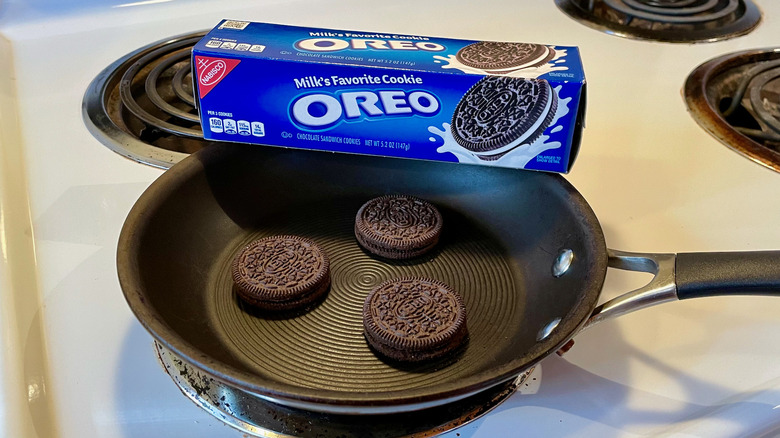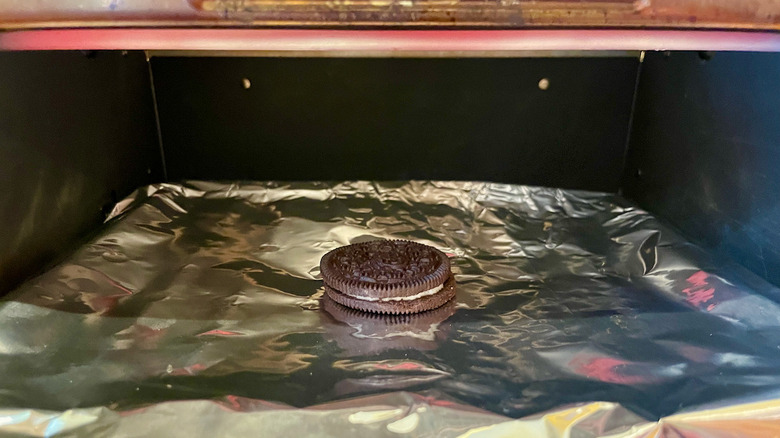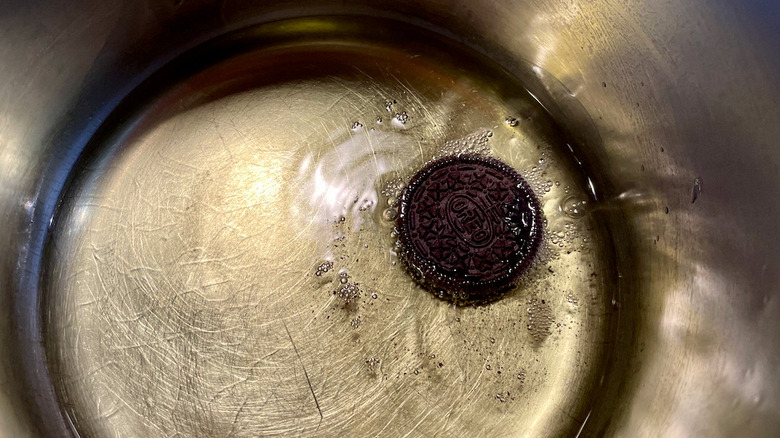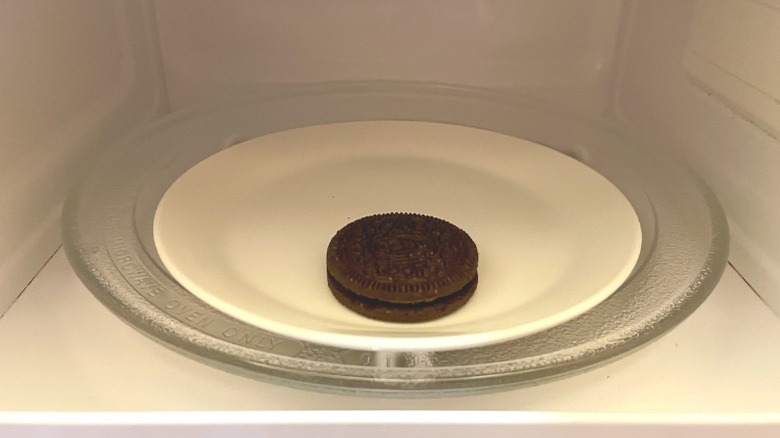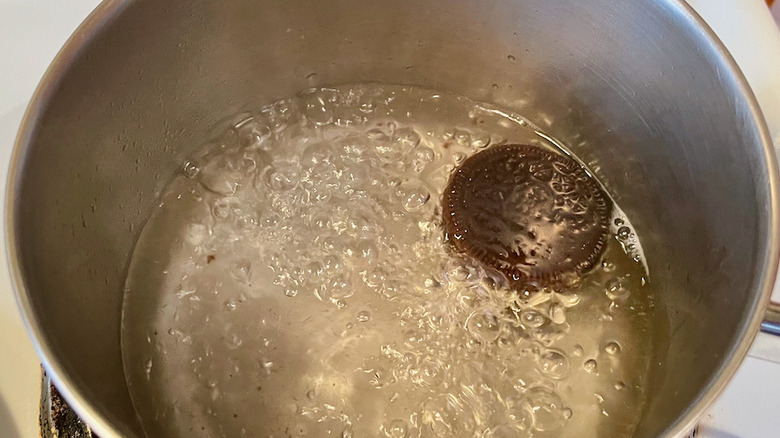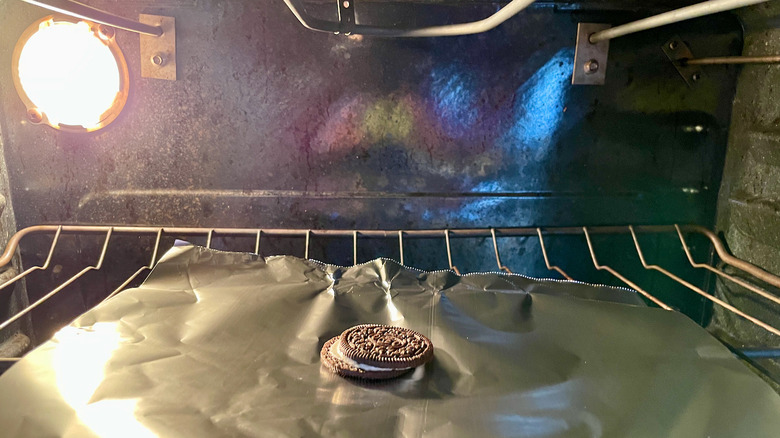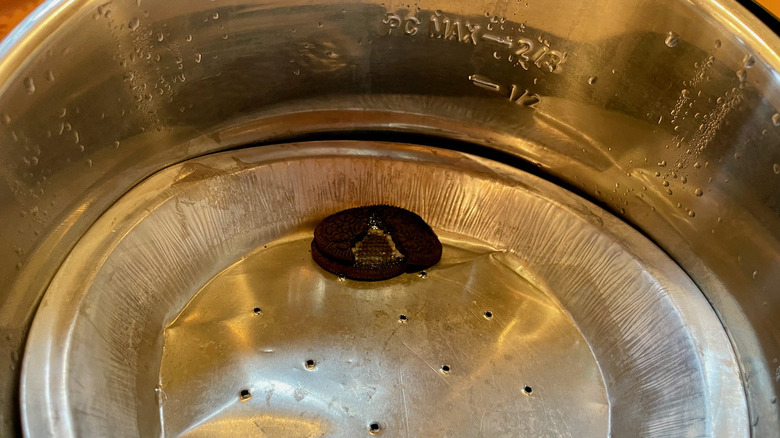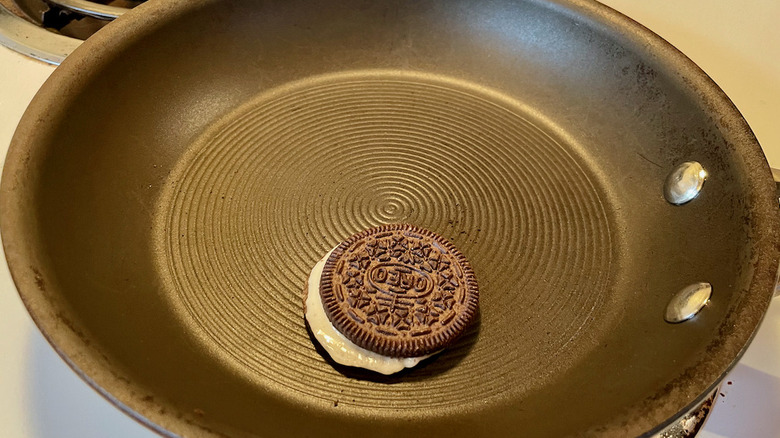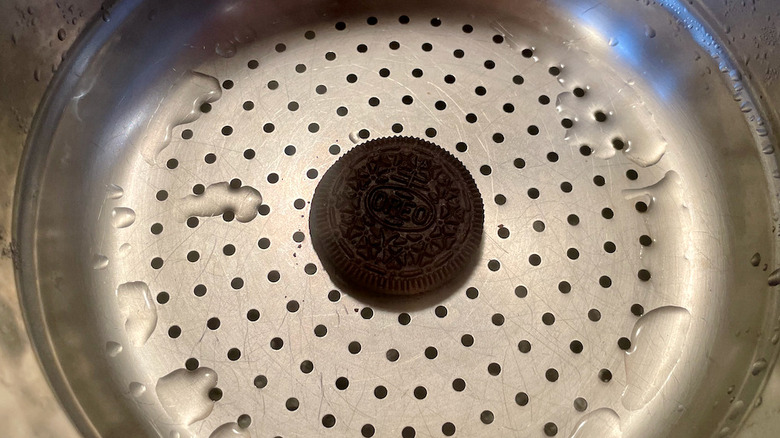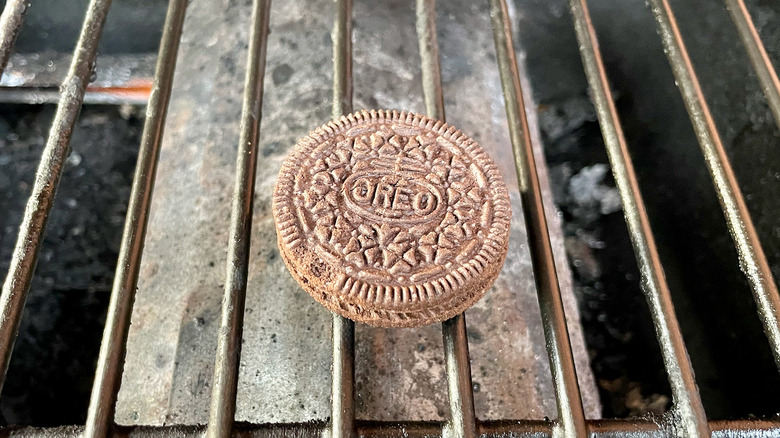We Tried 9 Methods Of Heating Up Oreos And It Was A Wild Ride
If you've been keeping up with food TikTok lately, you might have noticed a bunch of people posting about heating up Oreos. The search for the phrase "Your [sic] supposed to heat up Oreos" has over 42 million views, while "heating up an Oreo" has more than 580 million. It looks like TikTok user Technojail made this trend blow up, judging by the fact that he's commonly tagged in other people's videos about the phenomenon. In his original video, he jokingly admonishes people not to eat Oreos "raw," claiming (falsely) that the instructions on the packaging say to heat the cookies up in a skillet or a microwave.
As a public service to you, we had to test out whether it really is better to heat up Oreos than to eat them cold out of the box. But why stop with just the skillet or the microwave? We tried every method of heating up Oreos that we could think of. Some were gross, and some were great, but none were boring. Here are nine ways to heat up an Oreo, ranked from worst to best.
9. Toaster
Other than the microwave, the toaster oven is just about the easiest, most convenient way to heat food up, so we had high hopes for this cooking method. Unfortunately, it didn't really work very well.
We set our toaster oven to the lightest toasting setting and placed the Oreo on a piece of foil (we definitely didn't want to clean burned Oreo creme off of the bottom of our toaster if things went wrong). After the toasting cycle was over, the Oreo looked pretty much exactly the same as when it went in, except it was smoking, which wasn't a great sign. One of the challenges of properly cooking an Oreo is that the cookies are already the color of burnt food, so you can't tell if they're burning unless you smell them.
A taste test confirmed our worst suspicions: The cookie was burnt and bitter, with an unpleasant charcoal aftertaste. It had also dried out and hardened in a way that wasn't particularly pleasant. We wouldn't recommend this Oreo heating technique.
8. Fried
Fried Oreos are a classic carnival food treat. When you get them at a fair, they're typically covered in a batter that protects the cookie from the fryer oil. However, this article is about ways to heat up Oreos, not dishes you can make using Oreos as an ingredient, so we viewed adding a coating of batter as cheating. Thus, our brave Oreo took its oil bath in the nude.
The Oreo fried in 350-degree oil for about a minute, with a flip in the middle of the cooking process. As with the toaster oven, it was difficult to tell when the Oreo was done. Fried foods usually bubble while cooking because of moisture escaping, but there is very little moisture inside an Oreo. We pulled it when we could smell some toasty aromas and blotted away excess oil with a paper towel.
We were expecting the creme filling to dissolve in the oil, but it miraculously stayed in place. The cookies became very crispy in the oil. Unfortunately, they also absorbed a lot of grease. They tasted a little over-toasted, but even more so they tasted like straight fryer oil. The batter method is definitely the way to go for fried Oreos.
7. Microwave
The microwave is one of the methods specifically mentioned by TikTok user Technojail, so it was an obvious choice to include on the list. However, we can't say we expected much from the microwaved Oreo experience. Sure, the microwave is the lowest-effort way to make food hot, but is it ever the best way? Not really.
We nuked an Oreo at full power for about 30 seconds until the creme looked runny. The result was ... fine. The hot creme was nice, but the microwave did weird things to the texture of the cookie. It became a little bit tough and leathery. It did have good flavor, though, as heating it up made it taste a little bit like brownie batter. Overall, the microwaved Oreo wasn't bad, but we wouldn't say that it was better than a "raw" Oreo. If you're going to go to the trouble of heating up your Oreos, make the extra effort to use a method that actually adds something to the eating experience.
6. Boiled
If we're being honest, we just threw this method on the list because we thought it would be funny and gross, but shockingly, the boiled Oreo was actually pretty good. We boiled it for about 30 seconds until the cookies looked soft and had expanded slightly.
Just like with the fried Oreo, the creme somehow resisted dissolving — what do they make that stuff out of? The cookies were very soft on the outside, but they retained a slight crispiness on the inside. The parts of the cookies that had absorbed some water developed a saucy, creamy texture that was kind of enjoyable. It was like eating a warm, extra-creamy Oreo with chocolate sauce. We expected the nasty wet napkin texture that develops when bread gets soaked, but we were pleasantly surprised by the mouthfeel of our boiled Oreo. Boiling still wouldn't be close to our first choice for heating up an Oreo, but you could definitely do worse.
5. Oven
Oreos are already baked once, but what happens if they're baked twice? Do they turn into an Oreo version of biscotti, the famous Italian twice-baked cookie? Not exactly.
After five minutes in a 350-degree oven, the creme filling became boiling lava hot. If you bake your Oreos, learn from our mistakes and let them rest for a minute or two before digging in; we burned our tongues on the fresh-from-the-oven Oreo.
Other than safety issues, the baked Oreo was pretty good. Similar to the microwave, the oven brought out rich brownie-like notes in the chocolate cookie that we really loved. The texture was better than the microwaved Oreo too, though it still wasn't great; the oven dried out the cookies without making them crispy, turning them a little bit chewy. However, the lovely brownie taste of the baked Oreo made it the first method on the list that we'd say we preferred over eating one straight from the box.
4. Instant Pot
If there's one thing we've learned from writing about food on the internet, it's that Instant Pots equal guaranteed clicks, so we knew we had to try putting an Oreo inside everyone's favorite multicooker. Did we think it would be good? Absolutely not. Were we delighted by what happened? It turns out, yes.
To use the pressure-cooker function of an Instant Pot, there needs to be a little bit of water in the pot. We didn't want the Oreo to be submerged in liquid, so we suspended it over the water in a pie plate with holes punched in it. If we had been able to find our Instant Pot steamer insert, we would have used that, but it we could not.
The Instant Pot was the only heating method violent enough to dissolve the creme. After two minutes of cooking at high pressure, the Oreo looked, frankly, nasty. The cookies were beaten up and mushy, and the creme was nowhere to be found. We thought the creme had simply melted away, but after tasting, we concluded that it had actually absorbed into the cookies. The pressure-cooked Oreo was shockingly delicious. The creme-soaked, softened cookies tasted like chocolate-vanilla bread pudding. In conclusion, this method is a 0 out of 10 aesthetically but an 8 out of 10 in flavor.
3. Skillet
A skillet is the other method mentioned by TikTok user Technojail in his video, and it's a good one. We heated the Oreo in a dry nonstick skillet on medium heat, flipping a few times for even cooking. We called it done once the creme was gooey but not fully molten.
The best thing about the skillet method is what it did to the cookies. It made them extra crispy on the outside and soft on the inside. Even better, the cookies became slightly toasted. They didn't go over the edge into charred like the toaster oven Oreo did; the skillet just added some nice brown, caramelized flavor that contributed complexity and depth to the Oreo's taste.
The skillet was basically just as quick and easy as the microwave method while delivering significantly tastier results. We barely even had to clean out the pan after we were done, as the Oreo left very little mess. It probably had the best effort-to-benefit ratio of any of the cooking techniques we tested.
2. Steamed
This is another method that we tested mostly as a joke, but once again, the end product blew us away. We steamed the Oreo over boiling water for about five minutes. At the end of the cooking time, it looked basically the same as when it went in the steamer, but the texture was transformed. It was so delicate that it was hard to transfer onto a plate.
Steaming made the cookies and cream filling all become basically the exact same creamy texture. But they weren't just creamy — they were also fluffy. If you've ever had a Chinese bao bun, specifically the kind filled with egg custard, the steamed Oreo had a very similar mouthfeel. Unlike the boiled example, the steamed cookie wasn't waterlogged, and it held its shape quite well. Steaming completely transformed the Oreo in a positive way. If you've ever wondered what an Oreo would be like if it had the texture of hot, fluffy pudding, this heating method answers that question in a delightful fashion.
1. Grilled
We felt compelled to get a picture of an Oreo cooking on our barbecue grill, so we fired up the propane to see what would happen. We grilled the Oreo for about two minutes on our gas grill uncovered at maximum heat, flipping frequently. We knew it was ready when the creme started melting.
The knock against this method is that it's challenging. It's easy to drop the Oreo between the grill grates or to mangle it with the utensil you use to flip it over. We actually used a large set of culinary tweezers to move the Oreo around the grill, and if you happen to have a set handy, we'd recommend doing the same, as they offered the precision and delicacy this operation needed.
If you do try this method out, you'll be rewarded with an exceptional Oreo eating experience. The creme was hot and gooey, of course, but the cookies were also scrumptious. They became extra-crispy all the way through without burning, and they had a wonderful toasty flavor. If you tried this on a charcoal grill, we imagine it would impart a nice smoky taste as well. Despite the finicky process, this was our favorite Oreo heating method.
